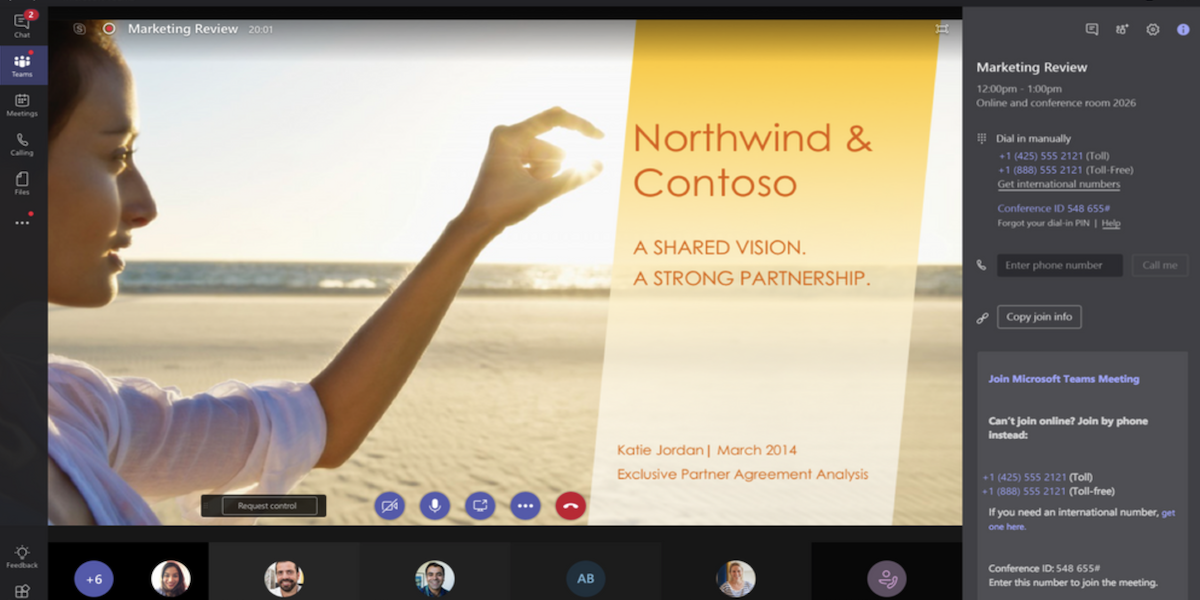Microsoft Teams enables you to host and participate in more productive meetings and invite anyone to join you. This makes Teams a perfect solution where you can communicate and meet with anyone inside or outside your organization – even if they are not a Teams user. This blog offers 9 tips to having more productive meetings with attendees in and outside your organization.
With these improvements, here are 9 tips to having more productive meetings with attendees in and outside your organization:
- Join a meeting via Audio Conferencing. What if you are on the road and don’t have access to the internet? Audio Conferencing (formally PSTN Conferencing) in Teams meetings is now generally available. Users who are enabled for enabled Audio Conferencing will automatically see dial-in instructions added to their Teams meetings. Dial-in numbers are supported in 90+ countries, 400+ cities, and 44 interactive voice response (IVR) languages. Dial-out to add an attendee via their phone number is also supported. The Audio Conferencing service in Office 365 can be enabled for any user of Office 365 and adds a low-cost audio conferencing to your Teams meetings so you can connect and collaborate with individuals on the phone as part of your meeting experiences.
- Invite anyone via email. Do you need to meet with someone outside of your organization? Don’t worry, with Anonymous Join, you can schedule a Teams meeting with anyone with a valid email address even if they are not in your organization. You can invite any valid email address to a meeting while scheduling either from Teams or from Outlook and they will receive the meeting invite in their email with information on how to join the meeting. Your meeting guest can click on the link, enter their name and join the meeting. Your guest will be able to join on web without having to install any client or if they want additional functionality, such as the ability to start sharing their screen, they can also install the desktop client and join anonymously.
- Admit attendees from the Lobby. Do you need a few seconds to get everything prepared? By default, all attendees who are not from your organization will arrive in a virtual lobby after which they will have to be admitted to join the actual meeting. This is done to enhance the privacy of your meetings – but also gives you time to make sure you’re ready for an important customer meeting. In the future, an admin will have the option to update the settings to allow anonymous users to join directly without having to go into lobby.
- Mute the noisy attendees. Tired of hearing a dog barking? In large meetings (> 5 people), anyone who joins after the meeting has started, will join as muted thereby reducing noise in the meeting. Further, if you notice any noise from others, you can mute that person, or mute everyone, easily from the roster. If someone has been muted, they’ll get a notification letting them know. They’ll be able to unmute themselves if they need to be heard. If you ever need to mute all the other participants in a meeting, head to your meeting roster and select ‘Mute all’. Everyone will get a notification and be able to unmute themselves if they need to.
- Join a meeting or initiate a phone call without a plug-in. Who has time for downloads?! You can now enjoy a plugin-less experience in a web browser where a meeting or a call just works! You can simply go to teams.microsoft.com from Edge or Chrome and to join a Teams meeting or from Edge to initiate a 1:1 call. Now, you are able join a meeting or call even when you do not have access to the Teams app through your desktop or mobile device.
- Share only the essentials. Don’t want everyone reading your email when you share your desktop? With Application sharing, you can choose to share a specific window instead of your entire screen. Rest assured that your desktop screen, or notifications are not shared when sharing your content in the meeting.
- Let others get in the driver seat. What happens when you see something someone else doesn’t? With Application Sharing, if someone is sharing their desktop, you can either request to have control of it or have the sharer give you control of their desktop.
- Get help with Interactive Troubleshooting. Have you ever forgotten to unmute yourself before you made a great argument in the meeting? With Interactive Troubleshooting, Teams will alert you if it detects you’re trying to speak but you are still muted. This is the first scenario of many scenarios where Teams can proactively detect and advise attendees of common issues that may impact their productivity during a meeting.
- View Call Analytics for Teams. If you need to troubleshoot a user’s meeting as an administrator, Call Analytics provides you and helpdesk professionals the ability to search for a Teams call history for a specified user calls and meetings to help troubleshoot issues with these experiences. If a user is using both Teams and Skype for Business Online, we strive to have tools you leverage for Skype for Business also work on Teams. With the preview of Call Analytics, all your users’ calls are in one place and we make it easy to identify which client was used.
If you don’t already have Teams, we encourage you to try it out to day with us.






